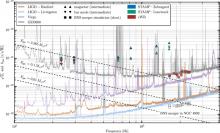
Abstract
The first observation of a binary neutron star coalescence by the Advanced LIGO and Advanced Virgo gravitational-wave detectors offers an unprecedented opportunity to study matter under the most extreme conditions. After such a merger, a compact remnant is left over whose nature depends primarily on the masses of the inspiralling objects and on the equation of state of nuclear matter. This could be either a black hole or a neutron star (NS), with the latter being either long-lived or too massive for stability implying delayed collapse to a black hole. Here, we present a search for gravitational waves from the remnant of the binary neutron star merger GW170817 using data from Advanced LIGO and Advanced Virgo. We search for short (≲1 s) and intermediate-duration (≲500 s) signals, which includes gravitational-wave emission from a hypermassive NS or supramassive NS, respectively. We find no signal from the post-merger remnant. Our derived strain upper limits are more than an order of magnitude larger than those predicted by most models. For short signals, our best upper limit on the root-sum-square of the gravitational-wave strain emitted from 1--4 kHz is h50%rss=2.1×10−22 Hz−1/2 at 50% detection efficiency. For intermediate-duration signals, our best upper limit at 50% detection efficiency is h50%rss=8.4×10−22 Hz−1/2 for a millisecond magnetar model, and h50%rss=5.9×10−22 Hz−1/2 for a bar-mode model. These results indicate that post-merger emission from a similar event may be detectable when advanced detectors reach design sensitivity or with next-generation detectors.